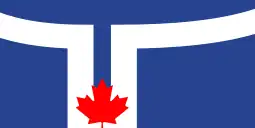
The Department of Canadian Heritage lays out protocol guidelines for the display of flags, including an order of precedence; these instructions are only conventional, however, and are generally intended to show respect for what are considered important symbols of the state or institutions.[1] The sovereign's personal standard is supreme in the order of precedence, followed by those for the monarch's representatives (depending on jurisdiction), the personal flags of other members of the Royal Family,[2] and then the national flag and provincial flags.
Many museums across Canada display historic flags in their exhibits. The Canadian Museum of History, in Hull, Quebec has many culturally important flags in their collections. Settlers, Rails & Trails Inc., in Argyle, Manitoba holds the second largest exhibit - known as the Canadian Flag Collection.
State
National
| Flag | Date | Use | Description |
|---|---|---|---|
.svg.png.webp) |
1965–present | National Flag of Canada (Maple Leaf Flag, l'Unifolié) |
A vertical bicolour triband of red, white, red with a red maple leaf emblem charged in the Canadian pale |
Ceremonial
| Flag | Date | Use | Description |
|---|---|---|---|
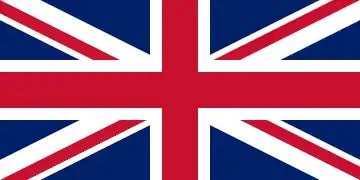 |
1965–present | Royal Union Flag | The Cross of St. Andrew counterchanged with the Cross of St. Patrick and over all the Cross of St. George. |
Provincial
| Flag | Date | Use | Description |
|---|---|---|---|
 |
1965–present | Flag of Ontario | A red field with the Royal Union Flag in the canton and the shield of the coat of arms of Ontario charged in the fly |
 |
1948–present | Flag of Quebec (The Fleurdelisé) | A blue field with an ordinary white cross and a white fleur-de-lis in each quadrant |
 |
1858 (first use)
1929 (arms adopted) 2013 (flag adopted) –present |
Flag of Nova Scotia | A banner of arms of the coat of arms of Nova Scotia |
 |
1965–present | Flag of New Brunswick | A banner of the coat of arms of New Brunswick |
 |
1965–present | Flag of Manitoba | A red field with the Royal Union Flag in the canton and the shield of the coat of arms of Manitoba charged in the fly |
 |
1960–present | Flag of British Columbia | A banner of the coat of arms of British Columbia |
 |
1964–present | Flag of Prince Edward Island | A banner of the coat of arms of Prince Edward Island within a bordure compony of red and white |
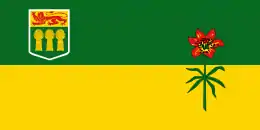 |
1969–present | Flag of Saskatchewan | A field party per fess, green and yellow, with the shield of the coat of arms of Saskatchewan in the canton and western red lily emblem charged in the fly |
 |
1968–present | Flag of Alberta | A blue field with the shield of the coat of arms of Alberta charged in the centre |
 |
1980–present | Flag of Newfoundland and Labrador | A blue and white field party per pale (at nombril point) with a white border, white ordinary cross and white saltire, two triangular divisions in the fly lined in red, a golden arrow between two triangular divisions |
Territorial
| Flag | Date | Use | Description |
|---|---|---|---|
 |
1969–present | Flag of the Northwest Territories | A vertical bicolour triband of blue, white, blue with the shield of the coat of arms of the Northwest Territories charged in the Canadian pale |
 |
1968–present | Flag of Yukon | A vertical tricolour triband of green, white, blue with the shield of the coat of arms of Yukon above a wreath of fireweed charged in the pale, with pale ratio of 1 to 1.5 to 1 |
 |
1999–present | Flag of Nunavut | A field party per pale, yellow and white, with a red inukshuk charged in the centre and a blue star in the upper fly |
Royal
| Flag | Date | Use | Description |
|---|---|---|---|
 |
2023–present | Royal Standard of Charles III, King of Canada | A banner of the Royal Arms of Canada undifferentiated |
.svg.png.webp) |
2011–present | Royal standard of the Prince of Wales | |
.svg.png.webp) |
2013–present | Royal standard of Princess Anne | |
.svg.png.webp) |
2014–present | Royal standard of Prince Andrew, Duke of York | |
.svg.png.webp) |
2014–present | Royal standard of Prince Edward, Duke of Edinburgh | |
 |
2015–present | Other members of the royal family | |
Viceregal and administrative
Governor general
| Flag | Date | Use | Description |
|---|---|---|---|
 |
1981–1999 2002–present | Flag of the governor general of Canada | A blue field with the crest of the Royal Arms of Canada charged in the centre |
Lieutenant governors and commissioners
Supreme Court of Canada
| Flag | Date | Use | Description |
|---|---|---|---|
| Link to file | Flag of the Supreme Court of Canada | ||
Military and civilian law enforcement organizations
Canadian Armed Forces
| Flag | Date | Use | Description |
|---|---|---|---|
 |
1968–present | Flag of the Canadian Armed Forces | A white field with the National Flag of Canada in the canton and the Canadian Armed Forces badge charged in the fly |
 |
1920–present | Flag of the Royal Military College of Canada | A field tierced per pale, red, white, and red with the badge of the Royal Military College of Canada charged in the centre |
 |
1920–present | Flag of the Royal Military College Saint-Jean | A field tierced per pale, blue, white, and blue with the badge of the Royal Military College Saint-Jean charged in the centre |
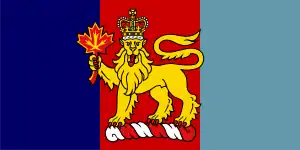 |
2000–present | Banner of the Commander-in-Chief Unit Commendation | A field tierced per pale, blue, red, and azure, with the crest of the Royal Arms of Canada charged in the centre |
 |
2009–present | Camp flag of the Cadet Instructors Cadre | The badge of the Cadet Instructors Cadre, with the traditional colours of the Navy, Army and the Air Force. The golden border represents the young people that CIC officers work for. |
 |
−1965 | King's Colour, as used by the Royal Military College of Canada | King's Colour of the Royal Military College of Canada with the Union Flag. |
Canadian Army
| Flag | Date | Use | Description |
|---|---|---|---|
.svg.png.webp) |
1939–1944 | Old flag of the Canadian Army | |
.svg.png.webp) |
1968–1998 | Old flag of the Canadian Army | |
.svg.png.webp) |
1998–2013 | Old flag of the Canadian Army | |
.svg.png.webp) |
2013–2016 | Old flag of the Canadian Army | |
 |
2016–present | Flag of the Canadian Army | A scarlet red field with the National Flag of Canada in the canton and the Canadian Army badge charged in the fly |
.svg.png.webp) |
–present | Flag of the Commander of the Canadian Army | |
Royal Canadian Navy
| Flag | Date | Use | Description |
|---|---|---|---|
 |
1968–present | Canadian Naval Ensign | A white field with the National Flag of Canada in the canton and charged in the fly with an anchor, eagle and naval crown in blue |
 |
1968–present | Canadian Forces Auxiliary Jack | A blue field with the National Flag of Canada in the canton and charged in the fly with an anchor, eagle and naval crown in white |
 |
c. 1964–present | Flag of the Canadian Navy Board | A field party per bend, blue and sanguine, with a fouled anchor in gold charged in the centre |
 |
RCN (1911–1965) RCSCC (1905–1965) |
Used as the ensign of the Royal Canadian Navy and some Royal Canadian Sea Cadets corps. Used throughout the entire British Empire by the Royal Navy and by several former British colonies even after they became independent and established their own navies. | White Ensign, St George's Cross with the Union Flag in the canton. |
.svg.png.webp) |
RCN (1921–1957) RCSCC (1929–1953) |
The Blue Ensign, worn as a jack by the Royal Canadian Navy and used by the RCSCC | Blue Ensign defaced with the Royal Arms of Canada. The maple leaves at the bottom of the shield are green. |
Royal Canadian Air Force
| Flag | Date | Use | Description |
|---|---|---|---|
.svg.png.webp) |
1941–1968 | Royal Canadian Air Force Ensign | |
 |
1982–present | Royal Canadian Air Force Ensign | A field of air force blue with the National Flag of Canada in the canton and the Royal Canadian Air Force roundel charged in the fly |
Canadian Special Operations Forces Command
| Flag | Date | Use | Description |
|---|---|---|---|
| Link to file | -present | Flag of the Canadian Special Operations Forces Command | A white field with the National Flag of Canada in the canton and the CANSOFCOM badge charged in the fly |
Canada Border Services Agency
| Flag | Date | Use | Description |
|---|---|---|---|
 |
2012–present | Flag of the Canada Border Services Agency | A Blue field with the National Flag of Canada in the canton and the Canada Border Services Agency badge charged in the fly |
Canadian Coast Guard
| Flag | Date | Use | Description |
|---|---|---|---|
 |
1962–present | Flag of the Canadian Coast Guard | A banner of the arms of the Canadian Coast Guard: vertical diband of white and blue, a red maple leaf emblem charged in the hoist and a pair of fish in gold and facing opposite directions charged in the fly |
 |
–present | Honorary Commissioner Flag | Governor General's flag in the canton. |
Police services
| Flag | Date | Use | Description |
|---|---|---|---|
 |
1991–present | Ensign of the Royal Canadian Mounted Police | A red field with a blue canton bordered yellow with a representation of the Badge of the RCMP |
| Link to file | 1998–present | Flag of the Ontario Provincial Police | Blue with the heraldic badge of the OPP |
 |
1983–present | Flag of the Sûreté du Québec | A green field, on a Canadian Pale Yellow charged with the badge of the Sûreté du Québec |
Youth cadets organizations
| Flag | Date | Use | Description |
|---|---|---|---|
.svg.png.webp) |
1953–1976[3] | Former flag of the Royal Canadian Sea Cadets | A white flag with a Union Flag at the canton, with the badge of the Royal Canadian Sea Cadets at the fly. This is the basis of the current flag of the Royal Canadian Sea Cadets. |
 |
1976–present[3] | Flag of the Royal Canadian Sea Cadets | A white flag with a Canadian Flag at the canton, with the badge of the Royal Canadian Sea Cadets at the fly. |
 |
2009–present[4] | Flag of the Navy League of Canada | A white flag with a Canadian Flag at the canton, with the current badge of the Navy League of Canada at the fly. |
 |
1985–present[5] | Banner of the Royal Canadian Army Cadets | A Canadian flag in the same shape as a queen's colour used in the Canadian Armed Forces, with the maple leaf modified with the badge of the Royal Canadian Army Cadets. At the canton, the cypher of Prince Philip, Duke of Edinburgh, as former colonel-in-chief of the Royal Canadian Army Cadets. At the fly, a badge representing the Canadian Army (the crown of Saint Edward above crossed swords). |
.png.webp) |
1944–1973 | Flag of the Royal Canadian Army Cadets used by individual Army Cadet Corps used before 1973. | |
 |
January 1973–present | Flag of the Royal Canadian Army Cadets used by individual Army Cadet Corps. | |
 |
Camp Flag of the Royal Canadian Army Cadets. | On a white field, the badge of the Royal Canadian Army Cadets in the centre. | |
 |
1995–present [6] | Flag of the Army Cadet League of Canada. | A banner of the shield of the arms of the Army Cadet League of Canada. According to the heraldic grant, the shield of the arms of the Army Cadet League of Canada is "Argent two swords in saltire Argent fimbriated Gules hilted and pommelled Or surmounted by a maple leaf Gules veined Or all within an orle of twelve maple leaves stems inward Gules."[7] The web site of the Governor General of Canada explains this description as follows: "The white shield, bearing a maple leaf and crossed broad swords, alludes to a central Canadian entity with direct connection to the military. The twelve smaller maple leaves show singleness of purpose but at the Branch level.[7] |
 |
1991–present [8][5] | Banner of the Royal Canadian Air Cadets | Based on the design of Queen's Colour for the Royal Canadian Air Force, with the badge of the Royal Canadian Air Cadets replacing the maple leaf. At the canton, the cypher of Prince Philip, Duke of Edinburgh, as former air commodore in chief of the Royal Canadian Air Cadets. On the bottom fly, the first badge of the Royal Canadian Air Cadets, a golden maple leaf above an eagle. |
 |
1971–present [8] | Ensign of the Royal Canadian Air Cadets | An Air Force blue flag, with a Canadian flag at the canton, with the historical badge of the Royal Canadian Air Cadets. |
.png.webp) |
Squadron Banner of the Royal Canadian Air Cadets | An Air Force blue flag, with the badge of the Royal Canadian Air Cadets and a scroll stating the squadron's name and number (this example, 643 St-Hubert Squadron. | |
 |
Camp flag of the Junior Canadian Rangers | A 1/3 red and 2/3 green flag with the badge of the Junior Canadian Rangers on the fly. | |
Civil
| Flag | Date | Use | Description |
|---|---|---|---|
.svg.png.webp) |
1922–1923 | Canadian Civil Aviation Ensign, briefly used by the Air Board. | A field of light blue with the Union Flag in the canton and a shield with white albatross superimposed upon three maple leaves in the middle of the fly. |
Corporations
Crown corporations
| Flag | Date | Use | Description |
|---|---|---|---|
 |
1992–present | Flag of the Canadian Broadcasting Corporation | A blue and red field with the logo of the Canadian Broadcasting Corporation charged in the centre; logo was first introduced in 1992 |
 |
1978–present | Flag of the Royal Canadian Mint | A red field with the logo of the Royal Canadian Mint charged in the centre; logo was first introduced in 1978 |
Hudson's Bay Company
Religious
| Flag | Date | Use | Description |
|---|---|---|---|
 |
–present | Flag of the Anglican Church of Canada | |
 |
–present | Flag of the Grand Orange Lodge of Canada |
Ethnic groups
Indigenous nations
| Flag | Date | Use | Description |
|---|---|---|---|
 | Unknown–present | Flag of the Anishinaabek | A black pictographic thunderbird on a white field |
 | Unknown–present | Simplified flag of the Atikamekw | |
 | Unknown–present | Flag of the Haida Nation | A red field with an eagle and raven headed bird, surrounded by a circlet, charged in the centre |
 | Unknown–present | Flag of the Innu Nation | Horizontal bands of teal, white and light blue, within the blue sits a centre snowshoe flanked by reindeer skulls on both sides |
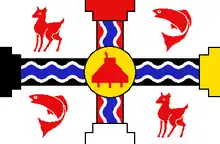 | Unknown–present | Flag of the Secwepemc Nation | Flag features 17 feathers representing the 17 bands in the Secwépemc Nation. The feathers are mostly black, with a white portion in the middle. The white portion signifies those communities which were wiped out by disease and other trauma following contact |
 | 2019–present | Flag of the Musqueam people | A white Canadian pale on a teal field, with an arrowhead in the centre depicting a salmon leaping above a net |
.svg.png.webp) | Unknown–present | Flag of the Mi'kmaq Nation Grand Council | A white field with a red Latin cross and a red star and moon in the left quadrants; white denotes purity of creation, the red cross represents mankind and infinity, the sun and moon the forces of day and night,[9] the flag is meant to be displayed hanging vertically as shown here[10] |
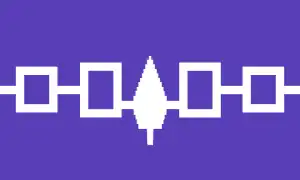 | 1980s–present | Flag of the Haudenosaunee Confederacy | A mauve field party per fess by a band of white squares joined and a stylized white "Tree of Peace" charged in the centre; design is adapted from the Hiawatha wampum belt, each element represents an original nation in the confederacy |
 | –present | Flag of the Gwichʼin | |
%252C_Quebec.gif) | Unknown–present | Flag of the Matimekush Band | A vertical tricolour triband of chartreuse, white, green with the coat of arms of the Matimekush Lac John Band charged in the Canadian pale |
 | Mid-1980s–present | Flag of the Natuaqanek Band | A red field with yellow left and right borders, a quartered roundel charged in the centre[9] |
 | Unknown–present | Flag of Ĩyãħé Nakón Mąkóce (Stoney Nakoda) | Stoney Nakoda flag |
| 2005–present | Flag of the Ktunaxa Nation | Flag features a golden feathered staff on a brown field | |
| 1980–present | Flag of the Nlaka'pamux Nation | Circle wreath of Nlaka'pamux pictographs set on a grey field | |
 | 2010–present | Flag of the Ojibwe | A blue and a brown block, with a symbol. |
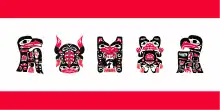 | 2012–present | Flag of Deisleen Ḵwáan, Lingít Aaní | Horizontally striped, red-white-red, 1-3-1, with five totems or emblems in the centre, from left to right: Kùkhhittàn (Raven Children), Ishklitàn (Frog), Yanyèdi (Wolf), Sèshitàn (Beaver), Dakhlʼawèdi (Eagle) |
 | Unknown–present | Flag of the Tahltan Nation | Flag of Tahltan Kolīne representing the two clans: Crow (or Tseskʼiya) and Wolf (or Chʼioyone) |
| 2001–present | Flag of the Nisg̱aʼa Nation | A vertical tricolour triband of black, white, and sanguine with the badge of the Nisga'a Nation,[11] surrounded by black and sanguine ovals, charged in the Canadian pale[12] | |
 | Unknown–present | Flag of the Nuxalk Nation | |
 | Unknown–present | Flag of the Tłı̨chǫ | A dark blue flag with thin centered horizontal white wavy stripe overlapping the bottom of a yellow sun disc with background-color fimbriation showing where these meet and four red teepees with white fimbriation and poles set in a row on the bottom half; yellow upright five-pointed star on the upper fly. |
 | Unknown–present | Flag of the Haisla people | |
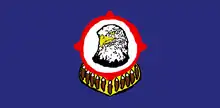 | Unknown–present | Flag of the Stʼatʼimc | |
 | Pre-1816–present | Flag of the Métis Nation of Canada | A blue field with a white symbol of infinity charged in the centre |
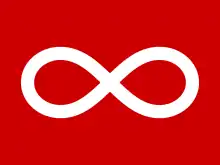 | Pre-1816–present | Flag of the Métis Nation (Red Variant) | A red field with a white symbol of infinity charged in the centre |
 | 2014–present | Flag of the Shíshálh | A white background with a bird charged in the middle. |
Blackfoot
| Flag | Date | Use | Description |
|---|---|---|---|
 |
Unknown–present | Flag of the Blackfoot Confederacy | |
 |
Unknown–present | Flag of Kainai Nation | |
 |
Unknown–present | Flag of Piikani Nation | |
 |
Unknown–present | Flag of Siksika Nation | |
Cree
| Flag | Date | Use | Description |
|---|---|---|---|
 | Unknown–present | Flag of Beaver Lake Cree Nation, Alberta | |
 | Unknown–present | Flag of Bigstone Cree Nation, Alberta | |
 | Unknown–present | Flag of Cree Nation of Wemindji, Quebec | |
 | Unknown–present | Flag of Cree Nation of Nemaska, Quebec | |
 | Unknown–present | Flag of the Driftpile First Nation, Alberta | |
 | Unknown–present | Flag of Enoch Cree Nation, Alberta | |
 | Unknown–present | Flag of Fisher River Cree Nation, Manitoba | |
 | Unknown–present | Flag of James Smith Cree Nation, Saskatchewan | |
 | Unknown–present | Flag of the Kapawe'no First Nation, Alberta | |
.PNG.webp) | Unknown–present | Flag of Kitchenuhmaykoosib Inninuwug First Nation, Ontario | |
 | Unknown–present | Flag of Mikisew Cree First Nation, Northwest Territories | |
 | Unknown–present | Flag of Neskantaga First Nation, Ontario | |
 | Unknown–present | Flag of the Nishnawbe Aski Nation, Ontario | |
 | Unknown–present | Flag of Nisichawayasihk Cree Nation, Manitoba | |
 | Unknown–present | Flag of Oujé-Bougoumou Cree Nation, Quebec | |
 | Unknown–present | Flag of Peguis First Nation, Manitoba | |
 | Unknown–present | Flag of the Peepeekisis Cree Nation, Saskatchewan | |
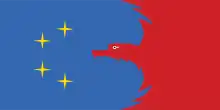 | Unknown–present | Flag of Pimicikamak Cree Nation, Manitoba | |
 | Unknown–present | Flag of Piapot First Nation, Saskatchewan | |
 | Unknown–present | Flag of Red Earth First Nation, Saskatchewan | |
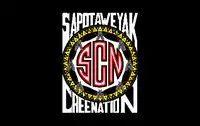 | Unknown–present | Flag of Sapotaweyak Cree Nation, Manitoba | |
Inuit
| Flag | Date | Use | Description |
|---|---|---|---|
 | 2005–present | Flag of Nunatsiavut | A white field with a white, green, and blue inukshuk charged in the centre |
 | 2018–present | Flag of NunatuKavut | The flag features an ulu, a traditional Inuit knife used by women. Within the ulu image is a dog sled team, showing the importance of husky dogs, as well as a kudlik, a traditional seal oil lamp |
.svg.png.webp) | unofficial | Flag of Nunavik | |
 | Unknown–present | Flag of Inuvialuit | |
Francophone peoples
| Flag | Date | Use | Description |
|---|---|---|---|
 |
1884–present | Acadian flag | Tri-colored flag, blue, white then red. A yellow star representing independence and unique culture from main land France. |
 | 1975–present | Flag of the Franco-Ontarians | A field party per pale, green and white, with a white fleur-de-lys charged in the hoist and a green trillium emblem charged in the fly |
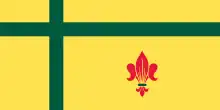 | 1976–present | Flag of the Fransaskois | A yellow field with a green Nordic cross centred towards the upper hoist and a red fleur-de-lis charged in the lower fly |
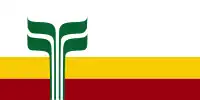 | 1980–present | Flag of the Franco-Manitobans | A white field with yellow over sanguine bars with a green plant emblem in four pieces charged in the hoist |
 | 1981–present | Flag of the Franco-Columbians | A white field party per pale by a bar gemelles and dancetty, a fleur-de-lys and Pacific Dogwood emblem charged in the fly; Dogwood is the floral emblem of British Columbia, the blue stripes evoke the Pacific Ocean and the rising mountains beside, the yellow centre of the Dogwood flower represents the sun |
 | 1982–present | Flag of the Franco-Albertans | A field party per bend sinister, blue and white, by a bend cotised white and blue with a white fleur-de-lys in the upper hoist and a red wild rose in the lower fly |
 | 1985–present | Flag of the Franco-Yukonnais | A blue field and three diagonal stripes set from lower hoist to upper fly. The colours of the stripes are white and golden yellow. The effect created by the arrangement of the stripes is meant to represent Yukon's many mountains. Blue is for the French people and the sky. White is for winter and snow. Yellow represents the gold rush and the Franco-Yukonnais contributions to history of the territory. |
 | 1986–present | Flag of the Fédération des Francophones de Terre-Neuve et du Labrador (Franco-Terreneuviens) | Three unequal panels of blue, white, and red, with two yellow sails set on the line between the white and red panels. The sail on top is charged with a spruce twig, while the bottom sail is charged with a pitcher flower. |
 | 1992–present | Flag of the Franco-Ténois | A polar bear on a snowy hill, looking forward towards a snowflake/Fleur-de-lis combined, representing the French community of the Northwest Territories of Canada. |
 | 2002–present | Flag of the Franco-Nunavois | Blue that represents the Arctic sky and white recalls the snow, abundantly present on the territory. The principal shape represent an igloo, and under this one, the inukshuk which symbolise the human presence. A single dandelion flower grows from beneath it. |
Other ethnic groups
| Flag | Date | Use | Description |
|---|---|---|---|
 | 2008–present | Flag of Gaelic Canadians | Adopted by the Comhairle na Gàidhlig (The Gaelic Council of Nova Scotia), the salmon represents the gift of knowledge in the Gaelic storytelling traditions of Nova Scotia, Scotland and Ireland and the Isle of Man. The “G” represents the Gaelic language and the ripples are the manifestations of the language through its rich culture of song, story, music, dance and custom and belief system.[13] |
 | 2021–present | Flag of Black Nova Scotians | The red represents blood and sacrifice. The gold conveys cultural richness. The green symbolizes fertility and growth. The black stands for the people.
The wave in the bottom centre has a dual meaning, representing the ocean and movements as well as honouring the journey of African Nova Scotian ancestors through the middle passage during the slave trade. On the left is half of a stylized heart (a version of the Sankofa symbol) with a yin and yang-like symbol embedded to represent heartbreak balanced with awareness. The image is encompassed with an incomplete circle representing those things absent but yet to come.[14] |
Municipal
Historical
National
| Flag | Date | Use | Description |
|---|---|---|---|
 |
1497–1707 | Flag on John Cabot's ship, and used during the English colonization of the Americas before the Act of Union. | White Ensign, St George's Cross. |
.svg.png.webp) |
1621–1707 | Flag used during the Scottish colonization of the Americas before the Act of Union. | White saltire on blue ensign, St. Andrew's Cross. |
.svg.png.webp) |
1689 | Merchant Flag of France | |
.svg.png.webp) |
1707–1801 | Flag of Great Britain | |
 |
1801–1964 | Union Flag (1801–1964); Canadian Royal Union Flag (1964–present) | |
Royal
| Flag | Date | Use | Description |
|---|---|---|---|
 |
1643 | Royal standard of France | |
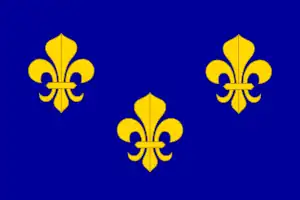 |
1534–1763 | Royal Banner of France or "Bourbon Flag" was the most commonly used flag in New France[15][16][17][18] | The banner flag has three gold fleur-de-lis on a dark blue field arranged two and one |
.svg.png.webp) |
1962–2022 | Royal standard of Elizabeth II, Queen of Canada | A banner of the Royal Arms of Canada defaced with a royal cypher of Queen Elizabeth II |
.svg.png.webp) |
2011–2022 | Royal standard of Prince William |
Coronation standards
| Flag | Date | Use | Description |
|---|---|---|---|
 | 1937 and 1953 | Coronations of George VI and Elizabeth and Elizabeth II | Banner of arms of Royal Coat of Arms of Canada |
 | 1911 | Coronation of George V and Mary | Banner of arms of Royal Coat of Arms of Canada |
Viceregal
Civil ensigns
| Flag | Date | Use | Description |
|---|---|---|---|
.svg.png.webp) |
1892–1922 | Canadian Red Ensign as authorized for use as a civil ensign through Admiralty warrant. Informal use of the Canadian Red Ensign as a symbol of Canada began as early as 1868. | |
.svg.png.webp) |
1907–1922 | 1907 informal version of the Canadian Red Ensign commonly used in western Canada. Note the inclusion of all the provincial emblems. | |
.svg.png.webp) |
1922–1957 | 1922 version of the Canadian Red Ensign used from 1922 to 1957, which was also used as a de facto national flag. | |
.svg.png.webp) |
1957–1965 | 1957 version of the Canadian Red Ensign that had evolved as the de facto national flag until 1965. | |
Newfoundland
| Flag | Date | Use | Description |
|---|---|---|---|
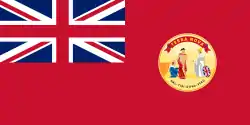 | 1907–1949 | Dominion of Newfoundland | |
.svg.png.webp) | 1870–1904 | Dominion of Newfoundland | |
.svg.png.webp) | 1862–1870 | Newfoundland Colony |
Rebellions
| Flag | Date | Use | Description |
|---|---|---|---|
 | 1968–1971 | Front de libération du Québec | Flag of the FLQ as seen at demonstrations in Montreal and the U.S. between 1968 and 1971[19] |
 | 1812–1821 | Pemmican War | Metis Flag |
 | 1837 | Lower Canada Rebellion | This flag was created by Marie-Louise Félix, Émilie Berthelot and Marie-Louise-Zéphirine Labrie in 1837, also involved in the Association of Patriotic Ladies of the Deux-Montagnes County. We see a maple branch surmounted by a muskellunge, surrounded by a crown of cone and pine branches. The C would mean "Canada" (in the sense that this term had for the Patriots at the time) and JB would mean "Jean-Baptiste", the patron saint of "Canadians" since the creation of the Société Saint-Jean- Baptiste in 1834. The original is in Château Ramezay, in Montreal. |
Other
| Flag | Date | Use | Description |
|---|---|---|---|
 | 1827 | Flag of the short lived Republic of Madawaska which was situated between Canada and the US. | |
 | 1868 | The Canadian Red Ensign used at Dominion Day celebrations in Barkerville, BC in support of Canadian Confederation, as Canada did not have an official flag.[20] | |
.svg.png.webp) |
Post 1910–c. 1945 | British Empire flag | An unofficial flag of the British Empire featuring symbols of its constituent dominions and India. The Canadian coat of arms are present in the bottom left. It was flown by civilians as a display of patriotism on special occasions such as Empire Day. A surviving specimen from the British Empire Exhibition in 1924 is kept in the Canadian Flag Collection.[21] |
Proposed
The following is a list of flags proposed for the Canadian state.[22]
| Flag | Date | Use | Description |
|---|---|---|---|
.svg.png.webp) | 1832–1838 | Patriote flag | The proposed flag for the Republic of Lower Canada (1838). It is still used today by some souverainists, in mostly 4 variants: the original, and three versions with the yellow star in the top left corner. Of which, two of them have Henri Julien's Patriot painting of 1904, one in colour and the other stylised in black and white. |
 | 1837–1838 | Flag of the Republic of Canada | A blue-white-red vertical tricolor with two white stars representing the colonies of Upper and Lower Canada and a crescent moon representing the "hunter's clubs" that organized and led the insurrection affixed at the hoist. |
.svg.png.webp) |
1902 | Design reported in the Daily Express to have been proposed as part of a series of Empire flags that would replace the Union Jack in representing individual territories of the British Empire[23] | The Cross of Saint George and the crown in the canton would have been present on all Empire flags to represent the English. In the top right would be the emblem of the territory flying the flag, and in this case, the coat of arms of Canada. A large sun in the centre symbolizes "the empire on which the sun never sets." |
.svg.png.webp) | 1930 | La Presse Proposal | Design inspired by the Australian flag. |
.svg.png.webp) | 1939 | Ephrem Côté's Proposal | |
 | 1946 | Proposed flag for Canada | A red British ensign defaced with a large golden maple leaf outlined in white in the fly. |
.svg.png.webp) | 1947 | Adélard Godbout's Proposal | |
.svg.png.webp) | 1957 | Jean-Francois Pouliot's Proposal | Green, detailed maple leaf on a red background. |
.svg.png.webp) | 1962 | John-Guy Labarre's Proposal | A green Compass rose on a white background. |
 | 1964 | Proposed flag for Canada by the Native Sons of Canada | Party per bend Gules and Argent a maple leaf Gules |
 | 1964 | Proposal made during the Great Flag Debate featuring one maple leaf. "Group C" finalist considered by Parliamentary committee.[24] | |
 | 1964 | Proposal made during the Great Flag Debate featuring four maple leaves | Four large maple leaves occupy the center of the flag. Behind them is a white diamond on a blue background. The leaves are arranged similarly to the modern heraldic mark of the Prime Minister, and their stems form the Cross of Saint George in the middle. |
.svg.png.webp) | 1964 | Proposal made during the Great Flag Debate featuring one maple leaf | The background is like the British flag without the diagonal stripes, there is a green maple leaf in the center and there are three stars on either side in the red stripe and two stars on either side in the vertical red stripe. |
 | 1964 | Proposal made during the Great Flag Debate featuring ten maple leaves | Ten maple leaves are spread across the flag, and they likely represent the provinces. On the left are red leaves on a red background. The right side features the same colours inverted. |
 | 1964 | Proposed flag for Canada, known as the Pearson Pennant | A blue field with a white square containing a three-leaf maple. The blue sides were meant to represent John A. Macdonald's description of the Canadian Pacific Railway and Canada's geography, "From sea to sea". |
 | 1994 | Proposed flag for Canada, known as the Canadian Unity Flag | Blue vertical stripes replacing part of the red bands, in approximate proportion to population of French heritage. |
 | 1996 | The Unilisé, a flag used by Canadian federalists in Quebec | A banner combining the flags of Canada and Quebec. Made in 1996 after the Quebec independence referendum by federalists who supported remaining with Canada to represent national unity. |
Regional
Official
| Flag | Date | Use | Description |
|---|---|---|---|
.svg.png.webp) | 1994–present | Flag of Cape Breton Island | A white field with four narrow horizontal stripes at the bottom, blue over green over yellow over gray with a narrow black fimbriation. Toward the fly, the green bar rises to silhouette a hill or island. Toward the hoist is a green, stylized eagle in flight.
Despite not being widely used, the Eagle flag was officially recognized and adopted by the Nova Scotian government in 1994.[25] |
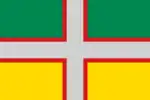 | 1938–present | Flag of Saguenay–Lac-Saint-Jean | A field party per fess, green and yellow, with a red-bordered grey ordinary cross; green represents the region's forests, yellow its agriculture, grey its industry and commerce, and red the vitality of the population |
Unofficial
| Flag | Date | Use | Description |
|---|---|---|---|
.svg.png.webp) | Disputed–present | Flag of Cape Breton Island | A field tierced per forest green and white, with a green saltire and yellow circle reading "Cape Breton Island" on the top, and "Canada" on the bottom, with a green stylized map of Cape Breton Island in the middle. The green is taken from the island's tartan.
Though being the most commonly used flag it is not the official flag and is disputed by supporters of the officially recognized 1993 flag designed by Kelly Gooding[25] |
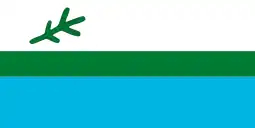 | 1974–present | Flag of Labrador | A field party per fess, white and azure, with a green horizontal band across the centre and a spruce twig in the upper hoist |
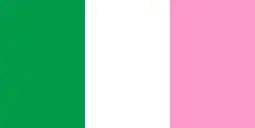 | 1880s–present | Newfoundland Tricolour | A field tierced per pale green, white, and pink |
 | 1949–present | Flag of Outer Bald Tusket Island | Flag used by one of the first micronation, name Principality of Outer Baldonia, it is sometimes used on fishing boats and on souvenirs. |
 | 1988–present | Flag of Vancouver Island | A Blue Ensign defaced with the great seal of the Colony of Vancouver Island. Used informally today.[26] This unofficial flag was designed in the 1980s to retroactively represent the colony (1849–1866). In 1865 the Crown gave colonies permission to place their badges on the fly of the Blue Ensign; thus vexillologists could argue that this flag is official.[27] |
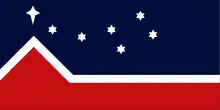 | 1988–present | Flag of Western Canada | Originally used by the Western Independence Party, it was designed in 1988 ahead of the party's first election. |
House flags of Canadian freight companies
| Flag | Date | Use | Description |
|---|---|---|---|
 | 1965–present | Canada Steamship Lines | |
.svg.png.webp) | 1958-1965 | ||
 | 1867-1958 | Quebec Steamship Company and Canada Steamship Lines | |
 |
1944–present | Coopérative de Transport Maritime et Aérien | The project differs in different periods of the company's activity. |
 |
1811–2019 | Bowring Brothers | |
 |
1893–1953 | Canadian Australasian Line | |
 |
1919–1986 | Canadian National Steamship Company | |
 |
1887–2005 | CP Ships | |
 |
19th–1967 | Job Brothers & Co., Limited | |
.svg.png.webp) |
1910–1916 | Royal Line | |
Yacht clubs of Canada
| Burgee | Club |
|---|---|
 |
Armdale Yacht Club |
 |
Barrachois Harbour Yacht Club |
 |
Bay of Quinte Yacht Club |
 |
Bras d'Or Yacht Club |
 |
Bronte Harbour Yacht Club |
 |
Buffalo Canoe Club |
 |
Dobson Yacht Club |
 |
Etobicoke Yacht Club |
 |
Northern Yacht Club |
 |
Oakville Yacht Squadron |
 |
Royal Hamilton Yacht Club |
 |
Royal Lake of the Woods Yacht Club |
 |
Royal St. Lawrence Yacht Club |
 |
Royal Vancouver Yacht Club |
 |
Royal Victoria Yacht Club |
 |
Royal Canadian Yacht Club |
 |
Royal Nova Scotia Yacht Squadron |
 |
Windsor Yacht Club |
 |
Queen's University at Kingston (College team) |
 |
University of British Columbia (College team) |
See also
References
- ↑ Department of Canadian Heritage. "Ceremonial and Canadian Symbols Promotion > Flag Etiquette in Canada". Queen's Printer for Canada. Retrieved 18 September 2010.
- ↑ Department of Canadian Heritage. "Ceremonial and Canadian Symbols Promotion > Personal Flags and Standards". Queen's Printer for Canada. Retrieved 18 September 2010.
- 1 2 "Flags of National Defence".
- ↑ "The Navy League of Canada [Civil Institution]". 12 November 2020.
- 1 2 "Heritage Structure | Annex A – Cadet Flags". 12 October 2018.
- ↑ "The Army Cadet League of Canada [Civil Institution]". 12 November 2020.
- 1 2 "The Army Cadet League of Canada [Civil Institution]". 12 November 2020.
- 1 2 Department of National Defence (2001-01-05). A-AD-200-000/AG-000 The Honours, Flags and Heritage Structure of the Canadian Forces Chap 4 Annex A. Directorate of History and Heritage.
- 1 2 "Canada > Index of Pages > First Nations > Mikmaq". Flags of the World. ISSN 1712-9842. Archived from the original on 4 July 2017. Retrieved 20 September 2010.
- ↑ "Flags of the World". Archived from the original on 2017-07-04. Retrieved 2010-09-20.
- ↑ Canadian Heraldic Authority. "The Public Register of Arms, Flags and Badges of Canada > Nisga'a Nation". Queen's Printer for Canada. Retrieved 20 September 2010.
- ↑ "Canada > Index of Pages > First Nations > Nisga'a Nation". Flags of the World. ISSN 1712-9842. Archived from the original on 6 October 2010. Retrieved 20 September 2010.
- ↑ "Gaelic Flags (Canada)".
- ↑ Currie, Brooklyn (February 15, 2021). "New official African Nova Scotian flag looking to connect past, present and future". CBC News.
- ↑ New York State Historical Association (1915). Proceedings of the New York State Historical Association with the Quarterly Journal: 2nd-21st Annual Meeting with a List of New Members. The Association.
It is most probable that the Bourbon Flag was used during the greater part of the occupancy of the French in the region extending southwest from the St. Lawrence to the Mississippi, known as New France... The French flag was probably blue at that time with three golden fleur - de - lis ....
- ↑ "Fleur-de-lys | The Canadian Encyclopedia". www.thecanadianencyclopedia.ca.
At the time of New France (1534 to the 1760s), two flags could be viewed as having national status. The first was the banner of France — a blue square flag bearing three gold fleurs-de-lys. It was flown above fortifications in the early years of the colony. For instance, it was flown above the lodgings of Pierre Du Gua de Monts at Île Sainte-Croix in 1604. There is some evidence that the banner also flew above Samuel de Champlain's habitation in 1608. ..... the completely white flag of the French Royal Navy was flown from ships, forts and sometimes at land-claiming ceremonies.
- ↑ "INQUINTE.CA | CANADA 150 Years of History ~ The story behind the flag". inquinte.ca.
When Canada was settled as part of France and dubbed "New France," two flags gained national status. One was the Royal Banner of France. This featured a blue background with three gold fleurs-de-lis. A white flag of the French Royal Navy was also flown from ships and forts and sometimes flown at land-claiming ceremonies.
- ↑ W. Stewart Wallace (1948). The Encyclopedia of Canada, Vol. II, Toronto, University Associates of Canada. pp. 350–351.
During the French régime in Canada, there does not appear to have been any French national flag in the modern sense of the term. The "Banner of France", which was composed of fleur-de-lys on a blue field, came nearest to being a national flag, since it was carried before the king when he marched to battle, and thus in some sense symbolized the kingdom of France. During the later period of French rule, it would seem that the emblem...was a flag showing the fleur-de-lys on a white ground.... as seen in Florida. There were, however, 68 flags authorized for various services by Louis XIV in 1661; and a number of these were doubtless used in New France
- ↑ Flags of the World (retrieved on 31 July 2007)
- ↑ "Dominion Day and the "New" Canadian Flag". Barkerville Historic Town & Park. 1 July 2019. Archived from the original on 2 August 2019. Retrieved 2 August 2019.
- ↑ Stevenson, Lorraine (23 May 2018). "Argyle museum waves the flag – all 1,300 of them". The Manitoba Co-operator. Archived from the original on 6 August 2021. Retrieved 20 August 2023.
- ↑ "Canada, flag proposals".
- ↑ "A British Empire Flag". The New York Times. The London Express. 9 February 1902. p. 3. Retrieved 20 August 2023 – via The New York Times Archives.
- ↑ "Are the Conservatives playing politics with the Canadian flag? - National | Globalnews.ca".
- 1 2 "Woman wants Cape Breton flag designed by her daughter recognized | Saltwire". www.capebretonpost.com. Retrieved 2020-09-30.
- ↑ FOTW Flags of the World: Vancouver Island (British Colony, Canada)
- ↑ Flags of Canada: British Columbia






